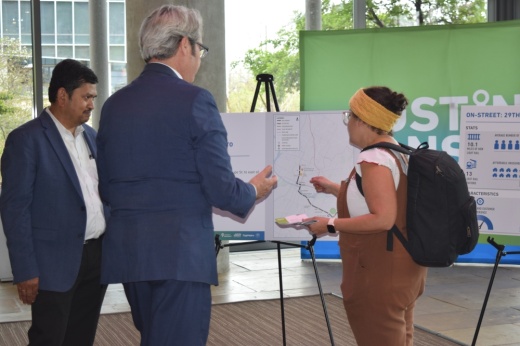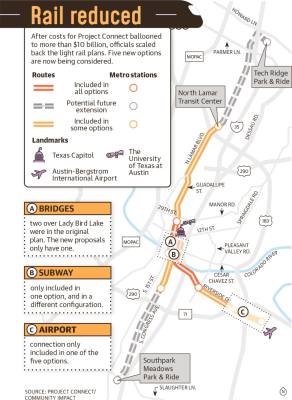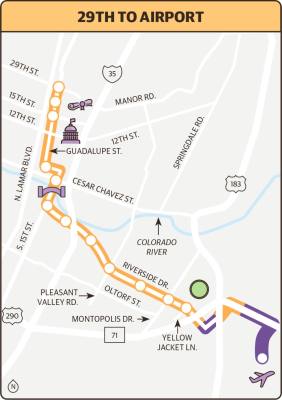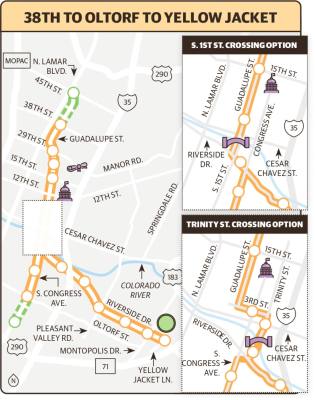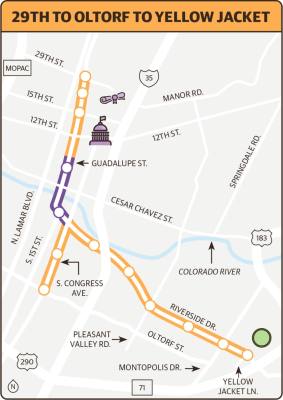Project Connect, originally estimated to cost $7.1 billion, was approved by voters in November 2020 with a property tax rate increase of $0.0875 to fund the project. Early plans included 28 miles of light rail that would go to Austin-Bergstrom International Airport, move through a downtown subway and cross Lady Bird Lake on two elevated bridges.
The options in consideration this spring are less than half the scale of the original 28-mile vision, and include the tunnel or the airport connection or neither. The rest of Project Connect, which includes a rapid bus system and commuter rail, is also delayed, according to officials.
During an open house March 29, officials with the Austin Transit Partnership—an independent government entity created to oversee the project—said there will likely be more additions to the light rail system down the road after phase one is selected in June.
The ATP announced in spring 2022 that the light rail’s price tag almost doubled in cost due to inflation, rising labor and construction costs, and increased real estate values. The cost exceeded what planners expect in funding through local tax collection and federal support, leading plans to be recalibrated, said ATP Treasurer Bryan Rivera.
While some residents have expressed frustration with having the plan scaled back from what was initially presented, it will not go back to voters to change the scope or require more taxes, said Casey Burack, executive vice president of business and legal affairs for the ATP.
However, state lawmakers are seeking to put Project Connect back to a vote. A bill moving through the House would force a new election for the ATP to issue bonds—part of its funding plan for the system.
Mayor Kirk Watson said he worked with lawmakers to improve what he called a “bad bill,” but that he expects its passage and would like to see the issue on this November’s ballot to keep rail plans moving along.
What happened
In 2020, nearly 60% of voters approved the tax increase for Project Connect.
Voters did not approve an exact plan for Project Connect; rather, the ballot language stated the tax increase would be for a citywide traffic-easing rapid transit system. The plan presented by the ATP included 28 miles of light rail, several rapid bus routes and $300 million for anti-displacement funding to be used to keep residents housed along the routes.
Originally, it was presented that the light rail portion would cost around $5.8 billion, but that estimate ballooned to more than $10 billion in 2022. Each of the redesigned options would cost about $5 billion, Rivera said, and are designed to receive federal approval and funding for 50% of the project.
“What was promised was a light rail system,” said Bill McCamley, executive director of pro-rail group Transit Forward. “Now, it’s time to figure out how to live within the budget from the tax and federal government.”
Community reaction
Austin resident James Dutcher said he is not happy with the proposal and how officials are handling it.
“[Transit officials] said, ‘Here’s what you’re getting,’ and then they came back and said, ‘Well, we can only actually do this,’” Dutcher said.
Although $300 million is earmarked anti-displacement, some residents such as North Austin resident Olivia Powell worry it may not be enough because of increased property values.
“There’s been a lot of discussion as to where it is going to go and how it may impact different vulnerable communities in Austin,” Powell said.
Capital Metro is spearheading an initiative with the ATP and the city of Austin in part to preserve existing communities. CapMetro officials said equitable transit-oriented development will focus on prioritizing underrepresented voices and aligning transit and housing strategies.
South Austin resident Deven Wilson said he feels officials are not being transparent enough about the process.
“We are giving ample time for the community to weigh in on these options. That’s our approach—coming back with solutions. We have been very consistent with transparency,” ATP Executive Director Greg Canally said.
Outgoing ATP board member Tony Elkins said he resigned in part due to transparency concerns.
Other officials, however, said they believe the presented options are a good starting point.
ABIA spokesperson Elizabeth Ferrer expressed support of Project Connect adding a line to the airport.
What happens next
The ATP has collected public feedback since the five options were unveiled March 21. A final option will be generated in late May and approved in June by ATP and CapMetro board members and Austin City Council.
It could include elements from the five proposals, Canally said, depending on expert and public feedback.
Typically light rail projects take six to eight years to complete, and construction will depend on the timing of the federal funding process, Canally said.
“Ultimately, the hope is we can get to the original vision of Project Connect over time,” Elkins said. “Obviously, it’s disappointing the program has shrunk, but this is happening all over the country.”
A vote on allowing the ATP to issue bonds could be called as soon as this fall if the state bill becomes law.
“The stakes are incredibly high because the election will determine whether light rail will proceed,” Watson said.




